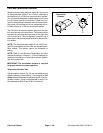
Groundsmaster 4500--D/4700--DPage 5 -- 44Electrical System
Piston (Traction) Pump Control Solenoid Coils
The piston (traction) pump uses anelectronic control as-
sembly for swash plate rotation. Electrical outputs from
the machine TEC controller are provided to two (2)
solenoid coils for pump control. The piston pump control
assembly is attached to the left side of the piston pump
(Fig. 53).
NOTE: To assist in troubleshooting, the piston pump
solenoid coils can be exchanged because they are
identical. If the problem follows the exchanged coil, a
problem with the coil likely exists. If the problem remains
unchanged, something other than the solenoid coil is
the problem source (e.g. traction pedal, circuit wiring,
hydraulic problem).
Solenoid Coil Testing
1. Park machine on a level surface, lower cutting
decks, stop engine, engage parking brake and remove
key from the ignition switch.
2. Locate piston pump solenoid coil to be tested (Fig.
53). Disconnect wire harness connector from solenoid
coil.
NOTE: Prior to taking small resistance readings with a
digital multimeter, short the meter test leads together.
The meter will display a small resistance value (usually
0.5 ohms or less). This resistance is due to the internal
resistance of the meter and test leads. Subtract this val-
ue from from the measured value of the component you
are testing.
3. Using a multimeter (ohms setting), measure resis-
tance between the two (2) connector terminals on the
solenoid coil. Solenoid coil resistance should be 3.66
ohms.
NOTE: Solenoid coil resistance should be measured
with solenoid at approximately 68
o
F(20
o
C). Resistance
may be slightly different than listed at different tempera-
tures. Typically, a failed solenoid coil will either be
shorted (very low or no resistance) or open (infinite re-
sistance).
4. If solenoid coil resistance is incorrect, replace coil:
A. Use a 12 point, 26 mm socket to loosen and re-
move the coil nut that secures solenoid coil.
B. Slide solenoid coil and O--rings from valve stem.
Clean all corrosion or dirt from the valve.
C. Slide new coil with O--rings onto the solenoid
stem.
D. Usea12point,26mmsockettoinstallandtorque
coil nut to 44 in--lb (5 N--m) (do not over tighten).
5. After testing is completed, connect wire harness
connector to the solenoid coil.
1. Piston pump
2. Forward solenoid coil
3. Reverse solenoid coil
Figure 53
FRONT
RIGHT
1
2
3
1. Solenoid coil
2. O--ring
3. Coil nut
Figure 54
1
3
2
2
1
3
2
2


















